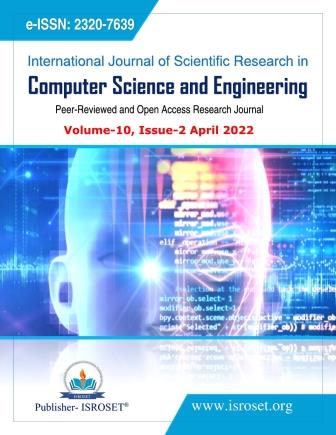Efficient and Simple Machine Learning-based Malware and Trojan Identification Tool
Keywords:
Malware, Internet Security, Machine LearningAbstract
When COVID-19 hit the world, it altered the working pattern of all the people around the world. Along with this, it is seen that there has been an exponential growth in the cases of malware, trojans and cyber-crime rates. New and recent malwares uses advanced techniques like polymorphism and metamorphism to help in assisting the malware detection and analysis procedure. Identifying malware in view of its features and conduct is analytic and serious for the computer security. Most of the anti-viruses that are present rely upon the signature-based noticing which is moderately easy to dodge and evade and is insufficient and also ineffective for zero-day exploit-based malware. With the ascent of the Internet, there has been enormous development in the quantity of malware on the planet. With this project, we provide a new approach to identify malware using static analysis, i.e. without executing. With the help of different machine learning models, we will identify malware if present in any file, to prevent any further attacks. The target audience and the people who will majorly get benefitted from this project are the students as well as the working professionals who are these days working in online mode due to the pandemic. This application will promote an easy use to identify the files that they receive over emails, SMS, or any other e-mode, to scan before opening any malware file and getting trapped. The target audience for this proposed system is mainly all the students, and professionals, who are more likely to be active on the internet.
References
O. Aslan and R. Samet, “A Comprehensive Review on Malware Detection Approaches,” IEEE Access, vol. 8, pp. 6249–6271, 2020, doi: 10.1109/ACCESS.2019.2963724.
Y. Suleiman, S. Sezer, G. McWilliams, and I. Muttik, “New Android malware detection approach using Bayesian classification,” Proc. - Int. Conf. Adv. Inf. Netw. Appl. AINA, pp. 121–128, 2013, doi: 10.1109/AINA.2013.88.
A. Kumar et al., “Malware detection using machine learning,” Commun. Comput. Inf. Sci., vol. 1232, pp. 61–71, 2020, doi: 10.1007/978-3-030-65384-2_5.
T. Alsmadi and N. Alqudah, “A Survey on malware detection techniques,” 2021 Int. Conf. Inf. Technol. ICIT 2021 - Proc., no. 2, pp. 371–376, 2021, doi: 10.1109/ICIT52682.2021.9491765.
A. Amamra, C. Talhi, and J. M. Robert, “Smartphone malware detection: From a survey towards taxonomy,” Proc. 2012 7th Int. Conf. Malicious Unwanted Software, Malware 2012, pp. 79–86, 2012, doi: 10.1109/MALWARE.2012.6461012.
S. Tenneriello, “Panoramas,” Herman Melv. Context, pp. 157–166, 2018, doi: 10.1017/9781316755204.017.
T. Alsmadi and N. Alqudah, “A Survey on malware detection techniques,” 2021 Int. Conf. Inf. Technol. ICIT 2021 - Proc., pp. 371–376, 2021, doi: 10.1109/ICIT52682.2021.9491765.
H. El Merabet and A. Hajraoui, “A survey of malware detection techniques based on machine learning,” Int. J. Adv. Comput. Sci. Appl., vol. 10, no. 1, pp. 366–373, 2019, doi: 10.14569/IJACSA.2019.0100148.
Z. Wang, Q. Liu, and Y. Chi, “Review of android malware detection based on deep learning,” IEEE Access, vol. 8, pp. 181102–181126, 2020, doi: 10.1109/ACCESS.2020.3028370.
H. S. Anderson, B. Filar, and P. Roth, “Evading Machine Learning Malware Detection,” BlackHat DC, p. 6, 2017, [Online]. Available: https://github.com/EndgameInc/gym-malware%0Ahttps://www.blackhat.com/docs/us-17/thursday/us-17-Anderson-Bot-Vs-Bot-Evading-Machine-Learning-Malware-Detection-wp.pdf.
D. J. Wu, C. H. Mao, T. E. Wei, H. M. Lee, and K. P. Wu, “DroidMat: Android malware detection through manifest and API calls tracing,” Proc. 2012 7th Asia Jt. Conf. Inf. Secur. AsiaJCIS 2012, pp. 62–69, 2012, doi: 10.1109/AsiaJCIS.2012.18.
H. W. Hsiao, D. N. Chen, and T. Wu, “Detecting hiding malicious website using network traffic mining approach,” ICETC 2010 - 2010 2nd Int. Conf. Educ. Technol. Comput., vol. 5, 2010, doi: 10.1109/ICETC.2010.5530064.
Omer Aslan, Abdullah Asim Yilmaz, "A New Malware Classification Framework Based on Deep Learning Algorithms," IEEE Access, vol. 9, pp. 87936-87951, 2021, doi: 10.1109/ACCESS.2021.3089586.
Sudhir Kumar Pandey, B.M. Mehtre, "Performance of malware detection tools: A comparison," 2014 IEEE International Conference on Advanced Communications, Control and Computing Technologies, 2014, pp. 1811-1817, doi: 10.1109/ICACCCT.2014.7019422.
Y. Pan, X. Ge, C. Fang and Y. Fan, "A Systematic Literature Review of Android Malware Detection Using Static Analysis," in IEEE Access, vol. 8, pp. 116363-116379, 2020, doi: 10.1109/ACCESS.2020.3002842.
Sweta Khatana, Anurag Jain, "Malware Detection Using the Behavioral Analysis of the Web based Applications and User," International Journal of Computer Sciences and Engineering, Vol.7, Issue.5, pp.1026-1031, 2019.
Jamuna Rani S., Vagdevi S., "Online Intrusion and Security Measures in Social Networking Environment – A Survey", International Journal of Computer Sciences and Engineering, Vol.8, Issue.12, pp.39-45, 2020.
Downloads
Published
How to Cite
Issue
Section
License

This work is licensed under a Creative Commons Attribution 4.0 International License.
Authors contributing to this journal agree to publish their articles under the Creative Commons Attribution 4.0 International License, allowing third parties to share their work (copy, distribute, transmit) and to adapt it, under the condition that the authors are given credit and that in the event of reuse or distribution, the terms of this license are made clear.







